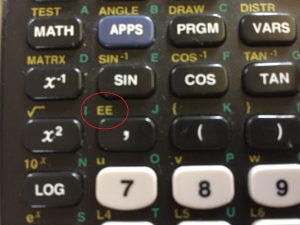2 Scientific Notation and Your Calculator
Powers of 10 are used when numbers are expressed in scientific notation. For example:
4.32 x 102 represents 432
4.32 x 10-2 represents 0.0432
Your textbook or this online text gives you more information and practice using scientific notation.
When doing calculations with numbers, it’s important to keep the power with the number. Using the EE or EXP key on your calculator will do this efficiently without the need to use parentheses. You can find the EE key above the comma on most Texas Instruments calculators (use the 2nd key to access).

You will press the EE or EXP key in place of the “X,” “10,” and “^” keys. For example, to enter 4.32 x 102 in your calculator, you would press 4 . 3 2 EE 2. You do NOT punch the X, 10, or ^ keys. If you want to type in a negative exponent, use the “(-)” key on your calculator instead of the minus key.
Using the EE or EXP key will keep the whole number together, including the times-ten-to-the-power part, so no parentheses are need when using that number in a calculation. See the following example.
Example 2.1
Calculate [latex]\frac{4.32x10^2}{3.65x10^8}[/latex].
Answer: This would be entered as 4 . 3 2 EE 2 [latex]\div[/latex] 3 . 6 5 EE 8 = to get an answer of 1.18 x 10-6.
In the example above, if you didn’t use the EE or EXP key (and without parentheses), the x 108 would go in the numerator, giving you an answer of 1.18 x 1010, which is off by 16 powers of 10, or 16 orders of magnitude!
When entering numbers in your calculator using the EE or EXP key, remember that numbers such at 103 are really 1 x 103 in scientific notation. Therefore, you would enter 1 EE 3 in your calculator, NOT 10 EE 3.

